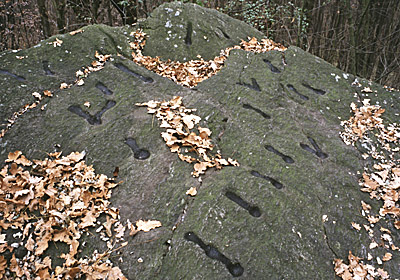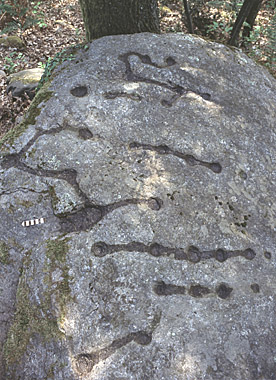Rock
engravings

Bessa was frequented before the gold mine exploitation
by Romans and the combining of the metal and high concentration of erratic
blocks, with surfaces suitable to be engraved, caused this presence, of which
we have important signs: more than 600 engravings mainly hemispheric shaped,
commonly called "cup marks". Despite a quite homogeneous distribution
most of the engraved rocks are concentrated between Filippi and Vermogno
hamlets (Zubiena) that is on 1/3 of the Terrace surface. This anomaly can be
explained as the morainal hills, delimiting the right side of Bessa, end in
Vermogno, and the settlements were probably placed on these sunny and safe
hills. It is clear that the acts connected to the engraving were near the
populated areas because of the high availability of surfaces. Rocks are
generally posed on little hillocks, planes and never in the shade, besides most
of the engravings are on horizontal surfaces or surfaces leaning towards the
sun and are in this case mostly concentrated on the upper part; these
characteristics suggest that a high sunny condition was predominant in the
choice.


Rock n.
14 Rock
n. 50 (evil rock)


Rock n. 29 Rock n. 32
Rock n. 43 Rock n. 31


Nowadays it is not possible to date the rock
engravings in Bessa as the exploitation has affected the surface layer of the
ground almost entirely; most of the surrounding high grounds went through a
continuous anthropization up to today and it has not been possible to conduct
any surveys at the roots of the few rocks that might have preserved the
original sediment. However the wide variety of types and dimensions suggest a
very long engraving period. Besides it is important to consider that the rocks
are situated between 370 and 340 m in height, in an ideal settlement area, near
streams. The idea according to which the rock engravings in Bessa developed
when the Romans exploited the mines should be abandoned, as their distribution
is limited to 1.5 km2, against a total surface of the upper Terrace superior to
4.5; in addition, the area where there is the larger concentration of
settlements relative to the roman mine does not coincide with the engraving
area. A still present echo of cults connected to stones can be found on two
rocks placed at the ends of the engraved area. The Roch d'la Sguia (sliding
rock) is a wonderful monolith (almost a huge egg) on which longitudinal
striations, due to the transport in the glacier, are still visible. On the
rounded back, besides a series of cup marks, there is the smooth sign produced
by several "slides" of women looking for fertility (and in recent
time by children playing). The old connection between stones and procreation is
well known in many parts of Europe and it is linked to protohistoric cultures
whose influence arrived to us. Opposed to the beneficial Roch d'la Sguia there
is the Roch Malegn (evil rock), a huge and sharp-edged rock broken into 3
pieces, that still today a few inhabitants of the area do not like to see or
mention. The predominant and sunnier fragment is engraved with a substantial
series of cup marks mainly connected two by two by a little channel. The
insisting presence of the couple theme suggests that also in this case the
fertility entered the history of this rock a long time ago; this could explain
its very bad fame probably due to an anathema of Christian origin.


Sliding
rock
Evil
rock
In despite of the several subdivisions provided by the
International Card of Rock Art, most of the cup marked rocks appear covered
with sequences of scattered signs apparently accidental. However in Bessa a
series of engravings that look like intentional compositions appear on two
rocks. The first one (n.5), situated below Roletti hamlet (Zubiena) presents on
the flat upper surface more than 80 cup marks; 61 of them seem organized in a
balanced structure and provided with symmetry, where the continuity and the
regularity of the signs suggest a wanted unit execution and seem to represent
an object provided with handle (a double row of cup marks), at its top, on the
left side, there is a trapezium form and on the right one a long appendage.
This "object" presents strong similarity with the "axes with bent handle" engraved on French megaliths, but
obviously the relationship is only a work hypothesis. The second rock situated
below Vermogno hamlet (Zubiena) presents 5 alignments of cup marks, partly
connected by little channels, parallel to each other. Also in this case the
composition of the signs seems to be intentional, considering that the
alignment of more than 3 cup marks is very rare both in Bessa (7 in total, 5 on
the examined rock) and anywhere else.


A serpentine shale staele, 2.90 m long, 60 cm wide and
80 cm thick has been located in Fontana del Buchin. The apical part is
prism-shaped, maybe simulating a head, from which bent shoulders descend. The
base of the presumed "head" presents a collar engraving, but because
of the schistosity of the rock, it has not been possible to determine if this
was intentional. A bent pectoral cavity, surely artificial, occupies the below
part for about 40 cm in height. The bottom part, narrowed down, ends with a
diagonal cut point, bordered by a rounded step working. The back surface, flat
in the shoulders, continues towards the bottom with convexity and concavity
hard to explain with natural erosion phenomena. The stele was in commanding
position towards the border of the Terrace, near the most abundant stream of
the Park, where there are no engraved rocks, and lies on the ground towards
south-east, in line with the winter solstice dawn. Archaeological inquires are
running to establish the dating for this important find, probably belonging to
a period prior to the roman presence.
